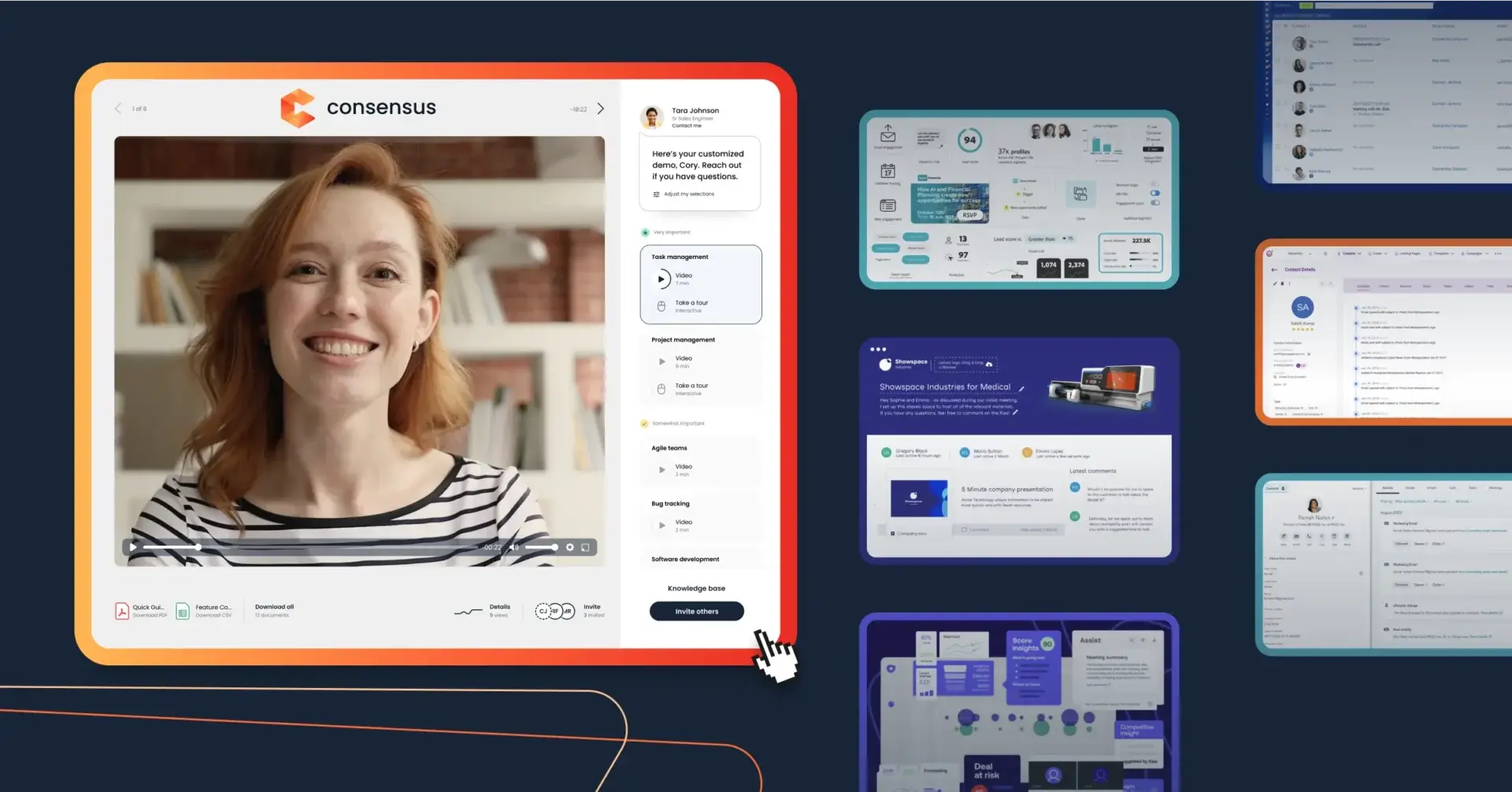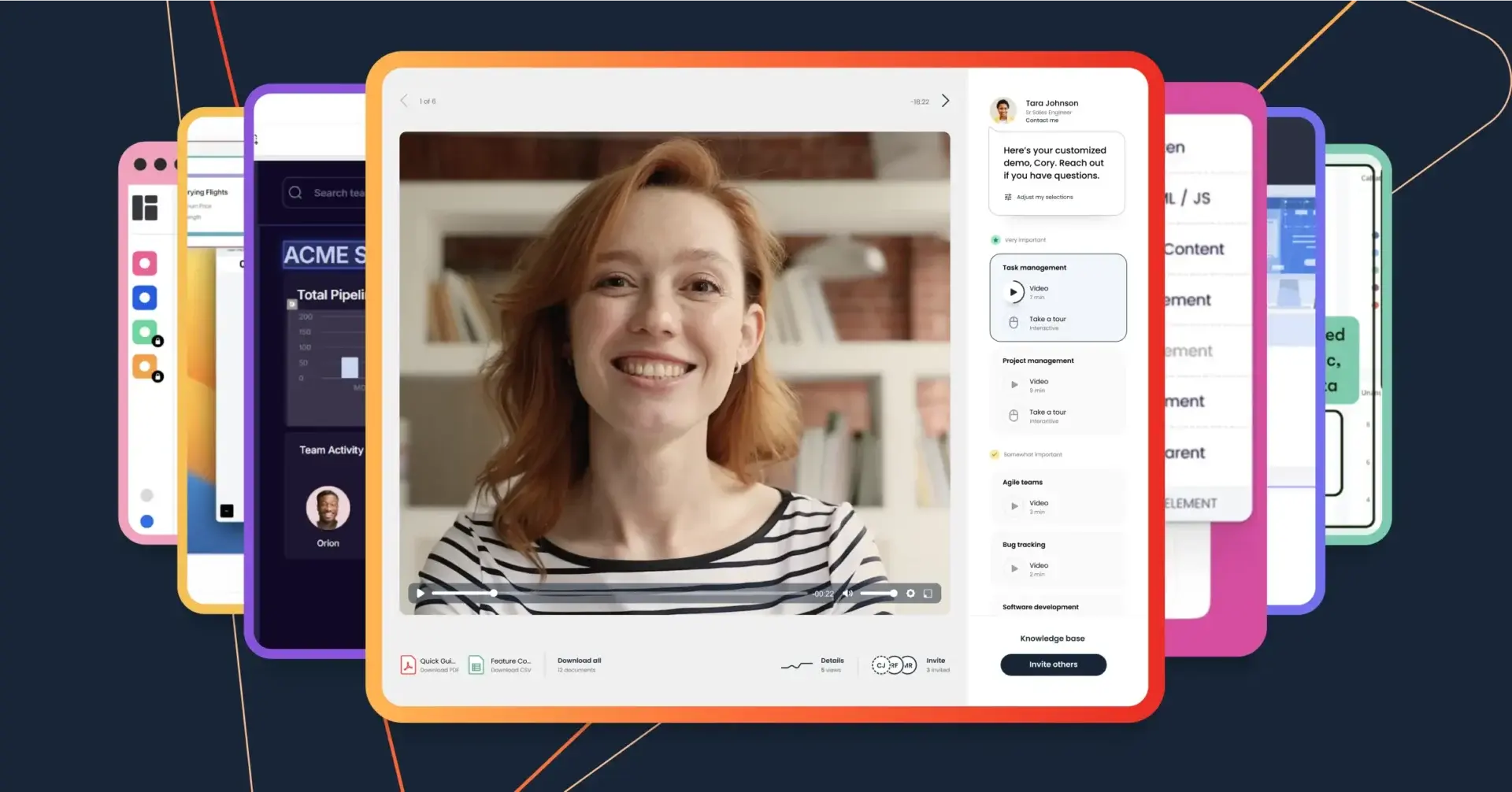Experienced marketing professional who focuses on revenue, enables sales teams, effectively ...
Close more deals with
Demo Automation.
Watch a Demo
We all know the drill: the sales landscape has flipped. Buyers are doing their own deep dives, pulling in the whole company for decisions, and frankly, they’re dodging those traditional sales calls like a bad cold. And here’s the kicker – this isn’t just a trend, it’s the new normal.
What does that mean for sales and revenue teams? Deals are dragging. Funnels are leaking. And, let’s be honest, top reps are spending too much time spinning their wheels with folks who aren’t ready to buy. We’re wasting precious resources, and that’s a problem.
This isn’t about blaming the buyer. They’re just adapting to the digital age. It’s on us to adapt, too. We need to figure out how to cut through the noise, engage these informed buyers on their terms, and stop letting deals slip through our fingers.
Think about it: are we still trying to force a square peg into a round hole? Are we still relying on old playbooks when the game has changed? Because if we are, we’re going to keep seeing those longer deal cycles, those broken funnels, and those wasted resources.
We need to rethink how we engage with these ‘Digital First Buyers’. How do we get them to experience our product on their terms, when they want, and in a way that allows them to collaborate with their team? That’s the challenge we need to solve.
How can revenue teams manage this exciting new sales world? One solution: sales funnel optimization. Optimizing your sales processes for moving buyers down the sales funnel helps sellers educate buyers, qualify leads, and connect with the right stakeholders. The stronger your funnel, the faster your deals close—and the more revenue you generate.
Defining Your Sales Funnel
Let’s be honest—there’s no such thing as a one-size-fits-all sales funnel. It’s more like a choose-your-own-adventure novel, and every company’s version has a few twists, detours, and secret tunnels along the way.
The traditional sales funnel is your roadmap for turning prospects into customers. It outlines the key stages buyers move through, from first learning about your product to making a purchase. The AIDA model—Awareness, Interest, Desire, Action—lays it out step by step, showing how buyers go from “Hmm, what’s this?” to “Take my money!”

So while you can start with AIDA, don’t stop there—because real buyers rarely follow a perfect script. You’ve got to go deeper. You need to map not just the ideal path, but the actual buyer journey—messy handoffs, back-and-forths, and all.
Remember that defining your sales funnel means understanding how your buyers behave. When, where, and how do they want to engage? Who needs convincing? Where do they drop off? This is the kind of insight that powers sales acceleration.
But first, let’s review the basics:
Awareness
Buyers can’t consider your solution if they don’t know you exist. Awareness is about getting in front of the right audience even before they realize they need you. Content marketing, search engine visibility, and targeted ads can help introduce your brand. Social proof, case studies, and industry insights position you as a trusted expert.
Interest
Once buyers recognize a need, they start researching options. This is where they evaluate whether your product aligns with their goals. A strong sales funnel provides interactive demos, educational content, and curated resources to help them explore.
It’s important to understand that the “interest” part of the traditional sales funnel has changed drastically. More and more buyers prefer to do their own research: about 100% of buyers say they want to use self-service tools during the sales process.
They need immediate access to decision-making information, from product capabilities and use cases to ROI expectations and peer reviews. They want to see how your solution works in real-world scenarios, compare it to competitors, and understand its impact—all before engaging with a sales rep.
For example, with demo automation, you can automate sending personalized, interactive product experiences on demand—letting buyers see firsthand how your solution drives success for their particular use case. This change represents a unique opportunity for sellers. By the time they connect with buyers, they’re more likely to be product-qualified leads—who are far more likely to convert.
Desire
Now, the buyer is serious. They’re comparing you against competitors, reviewing pricing, and evaluating ROI. This is where you differentiate yourself. Personalized demos, feature breakdowns, and success stories help reinforce the value of your solution.
With product experience platforms like Consensus, buyers can select exactly what features they want to see most and receive a demo tailored to their unique issues and use cases. You can also use the platform’s advanced analysis, Demolytics, to see who is firmly in the “desire’’ part of the funnel and who you can guide there. You know who has seen your demo, who has shared your demo, what features they keep rewatching, and much more. With these advanced analytics, you get all the information your sellers need to keep buyers moving down the sales funnel.

Action
Now it’s time for buyers to either commit or walk away—so make it easy for them to say yes. Remember that buyers don’t like to be kept waiting, and this stage is particularly crucial to move through quickly, so follow up faster to turn engaged leads into dedicated buyers. Streamline contracts, simplify onboarding, and offer clear next steps.
Ensure that you’re spending time in the right places with key decision-makers. Use Demolytics again to make sure you’re talking to someone with decision-making power.
9 of the Best Sales Funnel Optimization Strategies For Conversions
Sales leaders don’t have full control over the buying journey. Research shows they only get 17% of a buyer’s time throughout the process. That means most of the deal happens without them, making it crucial to create a seamless, self-guided experience that keeps buyers engaged.
To stay ahead, use these proven sales funnel optimization strategies to guide and influence buyers—even when your sellers aren’t in the room.
1. Implement Interactive Demos and Product Tours
Live demos are important—but let’s be real: they’re not always necessary, especially early in the buyer journey. Scheduling delays? Momentum killers. Repetitive intro calls with unqualified prospects? Major resource drain. And let’s not forget the biggest dealbreaker of all: buyers don’t want to wait. They want answers now.
That’s where interactive demos and product tours come in.
Imagine you’re researching solutions for your team—say, something to streamline your invoicing process. You land on a vendor’s website and… the best they’ve got is a generic white paper. It’s broad, non-personalized, and kind of a snooze. You know what’s coming next: a sales call you didn’t ask for, followed by a push to schedule another call to get a live demo. Cue the back-and-forth emails and a week-long wait for something that might not even be relevant.
Now, imagine the opposite. You exchange your email and—boom—you’re instantly invited to watch a personalized, on-demand demo that speaks directly to your priorities. No pressure. No pushy sales tactics. Just a quick, relevant glimpse into how the product solves your biggest challenges.
And once that demo has sparked your interest? You can dive even deeper with a self-guided product tour. This time, it’s hands-on. You get to explore the product on your own terms, interact with the features that matter most to you, and start building buy-in with real, tangible experience.

That’s the power of pairing product tours with interactive demos—because really experiencing a product is what builds a buyer’s confidence.
And that’s exactly where Consensus comes in. With Consensus, your buyers get an engaging, self-directed experience that adapts to their role, priorities, and timeline. They can interact with the product, explore features that matter most to them, and share those insights with their stakeholders—all without needing to book a meeting.
Watching gives buyers the “aha!” moment—Consensus captures their priorities and instantly delivers personalized, on-demand demos that spotlight the features and use cases most relevant to them.
Trying gives them a guided, hands-on look at exactly how your product works for their needs—no generic walkthroughs, just targeted, self-paced discovery.
Exploring lets them go deeper, playing with the product in a safe, simulated environment where they can follow their curiosity, get answers in real time, and start to envision what working with you actually feels like.
Meanwhile, your sellers get access to the first Product Experience Platform built to maximize their impact. The Consensus platform helps teams accelerate deal cycles and increase revenue by showcasing their complete solution, engaging stakeholders early, and proactively addressing prospect questions with relevant, on-demand content.
The result? More qualified pipeline, fewer dropped deals, and a faster path to closed-won. All while making the buying experience feel effortless.
2. Help Your Buyers to Sell to Themselves
Enabling buyers to access product information before meetings means that your buyers are essentially selling to themselves. And that’s exactly what modern buyers want. Today’s decision-makers don’t want to be sold to—they want to feel empowered, in control, and confident in their decision long before they have to speak with someone. Over 70% of today’s B2B buyers prefer a sales experience that doesn’t involve talking with a rep.
When buyers can explore demos and product tours on their own terms, they begin to build internal consensus, identify how your solution aligns with their pain points, and even start championing your product to other stakeholders. That’s the magic of self-driven discovery: it transforms passive interest into proactive buy-in.
By the time they hop into a meeting with your seller, they’re not just a lead—they’re a qualified, educated, and motivated champion who’s already doing the internal selling for you.
Revenue teams can use buyer enablement tools to build a sales funnel that removes friction. The goal is to make it as easy as possible for buying groups to buy from you during their first purchase and any renewals or expansions. They also deliver insights sellers can use to tailor outreach and engagement.
In addition to standard CRMs and content management systems, implement buyer enablement software like:
- Product experience platforms: Some of the most powerful buyer enablement tools help buyers directly interact with the product or an aspect of it. For example, product experience platforms like Consensus deliver automated demos, tailored product tours, and personalized simulations so buyers can see tools in action.
- AI-enabled sales tools: AI sales tools, like Consensus’ AI sales assistant Claraty, analyze buyer behavior, recommend relevant content, and streamline follow-ups to keep deals moving. By providing real-time insights into buyer engagement and intent, AI helps sellers prioritize the right opportunities and tailor their approach for maximum impact.
- Sales sandbox environments: Place your buyers in a controlled, data-rich product simulation without the hassle or strain on your engineering team. Give buyers access to sandboxes and proofs of concept (POC) experiences that buyers can confidently share with their team.
- Digital sales rooms (DSRs): DSRs create a single, shareable destination for every stakeholder in the buying group. Think of it as a microsite built for one account—housing demos, proposals, ROI calculators, contracts, FAQs, and more.
- Interactive ROI & value calculators: Value-selling tools embedded in platforms help buyers see the financial impact of your solution in their own context. These tools help justify investment, build urgency, and fuel internal buy-in.
3. Drive High-Intent Leads with Optimized Lead Capture Forms and CTAs
If your lead capture experience isn’t built for speed and clarity, you’re missing out on high-intent buyers who are ready to engage right now. The moment someone shows interest—whether it’s downloading a resource, watching a demo, or exploring your product—they should be met with a seamless, intuitive experience that encourages them to take the next step without hesitation.
Start with your forms. Long, clunky, or overly complex lead capture forms are one of the fastest ways to lose momentum. If buyers are forced to give up too much information just to get a glimpse of your product, they’ll bounce—and likely not come back.
Your lead capture strategy should feel less like a gate and more like a bridge—one that guides buyers toward meaningful interaction, while giving your team the insights needed to follow up intelligently. Optimize the lead capture process by:
- Keeping forms short and focused: Ask only for the essentials—name, email, company. The fewer fields, the better the conversion rate.
- Using multi-step forms: Break longer forms into smaller steps to reduce friction and create a sense of progress.
- A/B test everything: Try different form placements, button styles, and language to see what resonates most with your audience.
Once your forms are dialed in, focus on the CTAs that drive buyers to them. Vague CTAs like “Learn More” or “See Pricing” don’t cut it. Effective CTAs are direct and action-oriented. “Watch an Interactive Demo Now,” “See How It Works in 2 Minutes,” or “Get a Custom Product Tour,” eliminate hesitation and drive engagement.
You also want to ensure your CTA isn’t creating more work for the buyer. If you’re asking customers to “Book a Demo” instead of “Watch a Demo,” you’re asking them to jump through hoops when you could be offering them interactive product demos right from your CTA button.
4. Invest in Your Sales Engineers
Sales engineers (SEs) drive technical validation and help buyers see how a product fits their needs. But they’re stretched thin: There are too many unqualified demos, too many misallocated resources—and far too little time.
And what often goes unrecognized is how crucial SEs are in optimizing the entire revenue funnel. They’re not just demo deliverers—they’re collaborators across marketing and sales. They surface real buyer questions, help refine ideal customer profiles, and offer insights into which features resonate most with different personas. Their feedback improves everything from lead scoring models to demo content to product messaging.
When SEs share their frontline observations with marketing, it becomes easier to target and qualify the right buyers earlier in the funnel. And when sales leans on SE insights, they can focus their energy on high-value opportunities that are technically viable and more likely to close.
However, responsibilities aren’t getting removed from sales engineers’ roles, only added to. That means they have to do everything in a way that maximizes efficiency without sacrificing quality or customer experience.
It’s no wonder our 2025 Sales Engineering Compensation & Workload Report found that 80% of SEs experience some symptoms of burnout.

SEs believe receiving more recognition for contributions would have a positive impact. They want the same perks and incentives offered to sales teams to reward their impact on deal success, retention, and expansion.
They also want to be able to reduce repetitive tasks so they can be more strategic and creative in their everyday. And what do SE’s spend most of their time on? That’s right: technical demos. With demo automation tools like Consensus, SEs can offload repetitive product overviews, ensuring that buyers get the right information upfront—without requiring a live demo every time. Instead of spending hours on basic walkthroughs, they can focus on high-value engagements, like addressing complex technical concerns, tailoring solutions to specific use cases, and guiding buyers through more advanced evaluations.
When you automate repetitive product overviews and let SEs focus on strategic, high-impact interactions, they can step in where they’re needed most: helping buyers overcome roadblocks, ensuring deals don’t stall, and ultimately driving more revenue—without burning out.
5. Shorten Response Times to Inquiries
Seems simple, but it’s important. Buyers expect instant answers. If they have to wait for a response, they’ll move on. Slow response times can kill deals before they start. Thirty percent of prospects will go to a competitor if you don’t respond quickly enough. In comparison, responding to leads in the first minute increases conversions by nearly 400%.
So how do you stay fast without burning out your team? Here’s how to keep prospects engaged and moving forward—without delay:
- Use automated, interactive demos as your first response: Don’t send buyers a generic “Thanks for your interest” email. Deliver a personalized, on-demand demo instantly after form submission, so buyers can start engaging with the product while your team preps the next step.
- Deploy product tours to offer guided, hands-on exploration: Product tours are a powerful way to let buyers try the product immediately—without needing to wait for a live demo. When paired with demo automation, they deepen buyer engagement and help drive internal alignment before your team even steps in.
- Use live chat or AI-powered assistants on high-intent pages: Pages like pricing, product, or demo requests should offer instant access to real help. AI sales tools can answer questions in real time, recommend relevant product content, and guide buyers to the right next step—all without human lag.
- Set internal SLAs for first-touch response: Even a simple acknowledgment within 5–15 minutes can make a difference. Define your process and use automation to ensure nothing slips through the cracks.
Buyers move at the speed of curiosity—and your response needs to match. With tools like interactive demos, product tours, and AI-powered engagement, you don’t just respond faster—you create momentum that carries all the way to closed-won.
6. Personalize the Customer Journey
Buyers expect a tailored experience. Generic messaging and one-size-fits-all demos won’t convert—with more than 75% of buyers reporting that they’re more likely to purchase from, recommend, and repurchase from a business that offers personalized sales experiences. A well-optimized funnel delivers content based on buyer needs, roles, and stages in the process. It recommends relevant product features, showcases use cases that matter, and adapts as engagement increases.
Of course, personalization doesn’t mean customizing everything manually. It means using automation to serve the right content to the right person at the right time. For example, with personalized demo videos, buyers can select the features and use cases most relevant to them, ensuring they receive an experience tailored to their specific needs. Instead of sitting through generic overviews, they get a demo that speaks directly to their priorities—before they ever engage with a sales rep.

Consensus on-demand demo platform
Automate Lead Scoring and Nurturing
Sales teams waste too much time chasing cold leads and filling in blanks that automation could’ve handled. Lead scoring, qualification, and nurturing? These should be humming quietly in the background—feeding your sellers hot, ready-to-close opportunities.
The magic happens when your automation is powered by real buyer behavior. When someone watches a demo, dives into a product tour, or shares content with their team, that’s gold. And with the right scoring and nurturing systems, that activity turns into a roadmap for what to say next—and when to say it.
Here’s how to put that into motion:
- Score leads based on engagement that actually matters
- Assign points for demo views, product tour interactions, and shared assets.
- Mix in firmographics to filter for ideal-fit accounts.
- Use Consensus insights to identify internal champions and stakeholder engagement.
- Segment smarter, not harder
- Group leads by interest, role, or buying behavior.
- Tailor content by segment—so your outreach never feels generic.
- Know who’s ready for sales, and who still needs a little nurturing.
- Nurture automatically (and intelligently)
- Trigger drip campaigns based on real activity, not just timelines.
- Serve up educational content, case studies, and product comparisons—right when they’re most likely to care.
- Test subject lines and timing to get more eyes (and clicks) on your message.
By leveraging automation, teams can eliminate manual, repetitive tasks and free up more time for high-value interactions—ultimately accelerating deal cycles and boosting revenue.
7. Provide a Great Product Experience
Buyers don’t just want to hear about a product. They want to experience it. If the funnel doesn’t make that easy, they’ll look elsewhere. Interactive demos, self-guided tours, and hands-on trials let buyers explore in a way that makes sense for them. The more immersive the experience, the more confident they’ll be in their decision—even before they speak to sales. With product experience (PX) software, companies work from a central hub to manage, tailor, and improve the entire experience a customer or potential customer has with a product.
Consensus is the first Product Experience Platform (PXP) dedicated to the creation of a full-funnel product experience. Consensus lets buyers watch personalized demos, try out your platform through interactive product tours, explore on their own through product simulations, and track how buyers interact to inform sellers on the best way to engage a buyer.
With Consensus, you can sell your entire ecosystem, not just a product. Consensus empowers you to create interactive product stories that resonate with every stakeholder, engaging more buyers and driving larger deals. The “choose your own adventure” approach lets prospects explore solutions tailored to their needs, educating the entire buying team.
This leads to better-qualified meetings, bigger deals, higher revenue, and ultimately, beating quota numbers.
8. Retarget Leads with Remarketing Campaigns
Not every lead converts on the first visit—some might need a nudge. While 44% of salespeople may stop after one follow-up with a potential buyer, 80% of sales happen after at least five follow-ups.
Retargeting keeps your product top-of-mind for visitors who didn’t take action. Ads, email sequences, and personalized demo invites bring them back into the funnel. The key is to remind them why they were interested in the first place—without being pushy—so you can stay top-of-mind until they’re ready to commit.
9. Continuously Test and Refine Your Funnel
Funnels aren’t static. What worked last quarter might not work today. Regular A/B testing, demo engagement tracking, and buyer feedback ensure you’re continuously improving. Test messaging. Test timing. Test demo formats. Every small tweak can make a big impact on conversions. The goal is simple—make it as easy as possible for buyers to say yes.
And remember that video demos may be great to start the sales funnel, but they’re also powerful tools to use at the bottom of the funnel. Many think of bottom-of-the-funnel activities as those related to product features and pricing. But customers in the market for an expensive product also want to know just who they’re working with. When two providers are close on quality and price, perceived trustworthiness and commitment to service are often the deciding factors.
Optimize Your Sales Funnel to Improve Conversions
Sales funnel optimization isn’t about guessing. It’s about making every stage—from awareness to action—work harder. Buyers don’t move in a straight line. They backtrack, hesitate, compare, and consult multiple stakeholders.
Fine-tuning the process means reducing friction, automating where possible, and giving buyers what they need—when they need it. Today’s buyers are fully in control. They do their research, compare solutions, and make decisions before ever engaging with a salesperson. Consensus lets you sell the way buyers want to buy: on their terms and on their time. Let your product do the talking and provide buyers with the information they need, when they need it. Gain more digital senses and guide prospects towards a confident decision that ends with your product on top.
Watch a demo to learn more about how Consensus can help you optimize your sales funnel.





